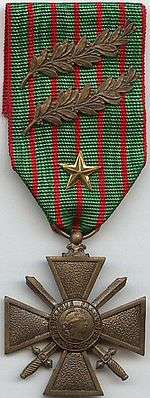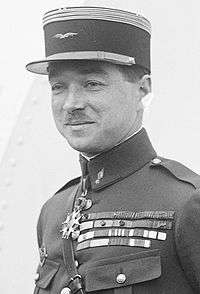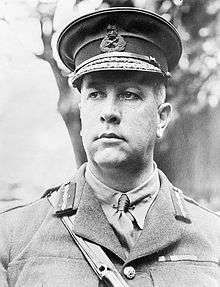Croix de guerre 1914–1918 (France)
The Croix de guerre 1914–1918 (English: War Cross) is a French military decoration, the first version of the Croix de guerre. It was created to recognize French and allied soldiers who were cited for valorous service during World War I, similar to the British mentioned in dispatches but with multiple degrees equivalent to other nations' decorations for courage.
| Croix de guerre 1914–1918 | |
|---|---|
 1914–1918 Croix de guerre with three citations 2 bronze palms 1 silver gilt star | |
| Awarded by | |
| Type | Medal |
| Awarded for | Military duty during World War I, valor in battle |
| Status | Closed |
| Statistics | |
| Established | 2 April 1915 |
| Total awarded | 2,065,000[1] |
| Precedence | |
| Next (higher) | Médaille nationale de reconnaissance aux victimes du terrorisme |
| Next (lower) | Croix de guerre 1939–1945 |
Ribbon bar & streamer of the French Croix de guerre 1914–1918 | |

Soon after the outbreak of World War I, French military officials felt that a new military award had to be created. At that time, the Citation du jour ("Daily Citation") already existed to acknowledge soldiers, but it was just a sheet of paper. Only the Médaille Militaire and Legion of Honour were bestowed for courage in the field, due to the numbers now involved, a new decoration was required in earnest. At the end of 1914, General Boëlle, Commandant in Chief of the French 4th Army Corps, tried to convince the French administration to create a formal military award. Maurice Barrès, the noted writer and parliamentarian for Paris, gave Boëlle support in his efforts.[1]
On 23 December 1914, the French parliamentarian Georges Bonnefous proposed a legislative bill to create the Croix de la Valeur Militaire ("Cross of Military Valour") signed by 66 other parliamentarians. Émile Driant, a parliamentarian who served in the war zone during much of this time, became its natural spokesman when he returned to the legislature. On 18 January 1915, Driant submitted this bill but the name of the military award was renamed to Croix de guerre ("War Cross"). After parliamentary discussions, the bill was adopted on 2 April 1915.[1]
World War I began in 1914 and ended in 1918, so the final name adopted is "Croix de guerre 1914–1918".
Award statute
Every Croix de guerre awarded carries at least one citation for gallantry or courage to a member of any rank of the French military or of an allied army. Ribbon devices indicate the importance or degree of the soldier's role during the action cited. The lowest degree is represented by a bronze star and the highest degree is represented by a bronze palm. The cross is only awarded once and subsequent actions worthy of citations will be limited to additional ribbon devices on the originally received insignia. The number of ribbon devices on a Croix de guerre is not limited, some awards, especially to ace fighter pilots, had extremely long ribbons with dozens of stars and palms.[1]
The Croix de guerre 1914-1918 was attributed to:
- French and allied soldiers individually cited for a wartime act of gallantry;[2]
- Civilians and militarized personnel individually cited for a wartime act of gallantry;[2]
- Automatically to soldiers and civilians not specifically cited for a Croix de guerre but awarded the Légion d'honneur or Médaille militaire for the highest acts of wartime valour and gazetted in the Official Journal of the French Republic;[2]
- Collectively, to army units, ships or air squadrons;[2]
- To cities and villages, martyrs of war, destroyed, ravaged or bombed by the enemy (2952 towns received the Croix de guerre 1914–1918, in this case, always awarded with palm).[2]
Soldiers who were/are members of units recognized by a collective unit award of the Croix de guerre may wear the Fourragère of the Croix de guerre 1914-1918 as long as they remain members of that unit. Soldiers who actively took part as members of units during repeated feats of arms recognized by more than one collective award of the Croix de guerre may continue to wear the fourragère even after leaving the meritorious unit.[1] Battle streamers in the colours of the Croix de guerre 1914-1918 are affixed to the colours of recipient units.
Award description
The cross was designed by the sculptor Paul-Albert Bartholomé. It is 37 mm wide, Florentine bronze cross pattée, with two crossed swords pointing up between the arms. The obverse centre medallion bears the relief image of the French Republic in the form of the bust of a young woman wearing a Phrygian cap surrounded by the circular relief inscription RÉPUBLIQUE FRANCAISE (FRENCH REPUBLIC). Not knowing how long the war would last, the reverse centre medallion bears the dates 1914–1915, 1914–1916, 1914–1917 and finally 1914–1918.[1]
The cross is suspended by a ring through a suspension loop cast atop the upper cross arm. It hangs from a 37 mm wide green silk moiré ribbon with seven narrow 1,5 mm wide vertical red stripes evenly spaced and two 1 mm red edge stripes.[2]

The lowest degree is represented by a bronze star and the highest degree is represented by a silver palm. The cross was worn with the appropriate attachments to signify the singular or multiple awards of the decoration.
- Bronze star (étoile de bronze): for those who were mentioned at the regiment or brigade level.[2]
- Silver star (étoile d'argent): for those who were cited at the division level.[2]
- Silver gilt star (étoile vermeil): for those who were cited at the corps level.[2]
- Bronze palm (palme de bronze): for those who were cited at the army level.[2]
- Silver palm (palme d'argent): could be worn in lieu of five bronze palms.[2]
 Étoile de bronze
Étoile de bronze Étoile d'argent
Étoile d'argent Étoile de vermeil
Étoile de vermeil Palme de bronze
Palme de bronze Palme d'argent
Palme d'argent
Notable French recipients (partial list)



- General Charles de Gaulle (1 citation)
- Fighter ace lieutenant Charles Nungesser (30 citations)
- Fighter ace captain Georges Guynemer (26 citations)
- General Edgard de Larminat (4 citations)
- General Joseph de Goislard de Monsabert (7 citations)
- Colonel Théophile Marie Brébant (4 citations)
- General Jean Vallette d'Osia (6 citations)
- General Raoul Salan (1 citation)
- Fighter ace colonel René Fonck (29 citations)
- General Marie-Pierre Kœnig (2 citations)
- General Raoul Magrin-Vernerey (11 citations)
- Fighter ace lieutenant-colonel Charles Nuville (10 citations)
- Fighter ace captain Georges Madon (10 citations)
- Marshal Joseph Joffre (1 citation)
- General Robert Nivelle (3 citations)
Notable foreign recipients (partial list)
- Corporal Eugene Bullard, French Air Force

- Major General Charles Budworth

- Lieutenant Colonel John Creagh Scott

- General George S. Patton

- General Douglas MacArthur

- Lieutenant General Lewis H. Brereton

- Brigadier General Edward Terence Donnelly

- Brigadier General Lucius Loyd Durfee

- Fighter ace Air Marshal William Avery "Billy" Bishop V.C.
.svg.png)
- Field Marshal Petar Bojović
.svg.png)
- Fighter ace Air Vice Marshal Raymond Collishaw
.svg.png)
- Air Chief Marshal Sir Keith Rodney Park

- General Sir Arthur William Currie
.svg.png)
- Fighter ace captain Robert A. Little

- Corporal Harry Miner V.C.
.svg.png)
- Captain Eddie Rickenbacker

- Private Needham Roberts

- General Sir Archibald Paris

- Philanthropist Julia Hunt Catlin Park DePew Taufflieb

- Private Herman Davis

- Private Robert Harbison

- Field Marshal John French, 1st Earl of Ypres

- Field Marshal Živojin Mišić
.svg.png)
- Fighter ace major James McCudden

- Fighter ace major Roderic Dallas
.svg.png)
- Sergeant Alvin C. York

- Sergeant George Lawson Keene

- Sergeant Henry Johnson

- Staff Sergeant Henry James Brasier, Mons Star, DCM, MM

- Director General Stephen Galatti, American Field Service

- Lieutenant Stephen W. Thompson, Lafayette Escadrille

- Lieutenant Giuseppe Franchi Maggi,[3] Royal Italian Army

- Lieutenant Charles B. Cleary is a member of Battery F, 7th Field Artillery

- Carrier Pigeon Cher Ami, Lost Battalion (World War I)

- Lt William F. Howe, 2nd Battle of Marne - w Gold Star

- Lt Quentin Roosevelt

- Corporal Henry John Kohn 6th Australian Infantry
- Fighter ace Captain Vernon Castle

French recipient units (partial list)
- 1st Infantry Regiment[1]
- 54th Infantry Regiment[1]
- 126th Infantry Regiment[1]
- 2nd Battalions of Light Infantry of Africa[1]
- 1st Cuirassier Regiment[1]
- 12th Cuirassier Regiment[1]
- 6th Dragoon Regiment[1]
- 9th Hussar Regiment[1]
- 1st Artillery Regiment[1]
- 2nd Dragoon Regiment[1]
- 1st Moroccan Division[1]
- French battleship Bouvet[1]
- French battleship Gaulois[1]
- French submarine Bernouilli[1]
- Lafayette Escadrille


Allied recipient units (partial list)
- Portuguese Expeditionary Corps 15th Infantry Battalion

- Russian Expeditionary Force Russian Legion Battalion

- The Black Watch

- 2nd Motorized Field Ambulance

- 5th Field Artillery Regiment

- 2nd Infantry Division

- 3rd Infantry Division

- 4th Infantry Division

- 26th Infantry Division

- 32nd Infantry Division

Recipient cities (partial list)
See also
- Ribbons of the French military and civil awards
- Croix de guerre 1939–1945
- Croix de guerre des Théatres d'Opérations Exterieures
- Croix de guerre (Belgium)
References
- Marc Champenois. "Croix de guerre 1914–1918" (in French). France-phaleristique.com. Retrieved 2014-05-23.
- Décret du 23 avril 1915 relatif à l'application de la loi du 8 avril 1915 instituant une croix de guerre.
- Schindler, John R.; Cavaciocchi, Alberto; Ungari, Andrea (2004). Gli italiani in guerra. Milano: Ugo Mursia Editore s.r.l. ISBN 8842550647.
- "Communes décorées de la Croix de guerre 1914-1918" (PDF) (in French). Association du Mémorial des batailles de la Marne. 14 December 2014. Retrieved 2016-12-28.
External links
| Wikimedia Commons has media related to Croix de guerre 1914-1918 (France). |
- France Phaléristique (in French)
- Museum of the Legion of Honour (in French)